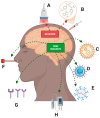Evolution of Alzheimer's Disease Therapeutics: From Conventional Drugs to Medicinal Plants, Immunotherapy, Microbiotherapy and Nanotherapy
- PMID: 39861773
- PMCID: PMC11768419
- DOI: 10.3390/pharmaceutics17010128
Evolution of Alzheimer's Disease Therapeutics: From Conventional Drugs to Medicinal Plants, Immunotherapy, Microbiotherapy and Nanotherapy
Abstract
Alzheimer's disease (AD) represents an escalating global health crisis, constituting the leading cause of dementia among the elderly and profoundly impairing their quality of life. Current FDA-approved drugs, such as rivastigmine, donepezil, galantamine, and memantine, offer only modest symptomatic relief and are frequently associated with significant adverse effects. Faced with this challenge and in line with advances in the understanding of the pathophysiology of this neurodegenerative condition, various innovative therapeutic strategies have been explored. Here, we review novel approaches inspired by advanced knowledge of the underlying pathophysiological mechanisms of the disease. Among the therapeutic alternatives, immunotherapy stands out, employing monoclonal antibodies to specifically target and eliminate toxic proteins implicated in AD. Additionally, the use of medicinal plants is examined, as their synergistic effects among components may confer neuroprotective properties. The modulation of the gut microbiota is also addressed as a peripheral strategy that could influence neuroinflammatory and degenerative processes in the brain. Furthermore, the therapeutic potential of emerging approaches, such as the use of microRNAs to regulate key cellular processes and nanotherapy, which enables precise drug delivery to the central nervous system, is analyzed. Despite promising advances in these strategies, the incidence of Alzheimer's disease continues to rise. Therefore, it is proposed that achieving effective treatment in the future may require the integration of combined approaches, maximizing the synergistic effects of different therapeutic interventions.
Keywords: Alzheimer’s disease; fecal microbiota transplantation; immunotherapy; medicinal plants; miRNAs; nanotechnology; probiotics.
Conflict of interest statement
The authors declare no conflicts of interest.
Figures




Similar articles
-
Advances on Therapeutic Strategies for Alzheimer's Disease: From Medicinal Plant to Nanotechnology.Molecules. 2022 Jul 28;27(15):4839. doi: 10.3390/molecules27154839. Molecules. 2022. PMID: 35956796 Free PMC article. Review.
-
Features and outcomes of drugs for combination therapy as multi-targets strategy to combat Alzheimer's disease.J Ethnopharmacol. 2018 Apr 6;215:42-73. doi: 10.1016/j.jep.2017.12.015. Epub 2017 Dec 14. J Ethnopharmacol. 2018. PMID: 29248451 Review.
-
Influence of Acetylcholine Esterase Inhibitors and Memantine, Clinically Approved for Alzheimer's Dementia Treatment, on Intestinal Properties of the Mouse.Int J Mol Sci. 2021 Jan 20;22(3):1015. doi: 10.3390/ijms22031015. Int J Mol Sci. 2021. PMID: 33498392 Free PMC article.
-
Differential effects of current specific treatments on behavioral and psychological symptoms in patients with Alzheimer's disease: a 12-month, randomized, open-label trial.J Alzheimers Dis. 2014;39(3):477-85. doi: 10.3233/JAD-131190. J Alzheimers Dis. 2014. PMID: 24164733 Clinical Trial.
-
Microbiota-gut-brain axis and related therapeutics in Alzheimer's disease: prospects for multitherapy and inflammation control.Rev Neurosci. 2023 Apr 20;34(6):695-718. doi: 10.1515/revneuro-2023-0006. Print 2023 Aug 28. Rev Neurosci. 2023. PMID: 37076953 Review.
References
-
- Yao D., Li T., Yu L., Hu M., He Y., Zhang R., Wu J., Li S., Kuang W., Yang X., et al. Selective degradation of hyperphosphorylated tau by proteolysis-targeting chimeras ameliorates cognitive function in Alzheimer’s disease model mice. Front. Pharmacol. 2024;15:1351792. doi: 10.3389/fphar.2024.1351792. - DOI - PMC - PubMed
-
- WHO. [(accessed on 12 December 2024)]. Available online: https://www.who.int/news-room/fact-sheets/detail/dementia.
Publication types
Grants and funding
LinkOut - more resources
Full Text Sources

